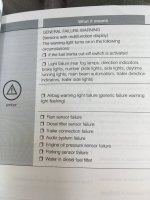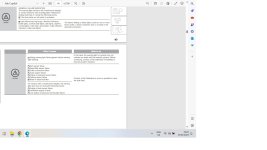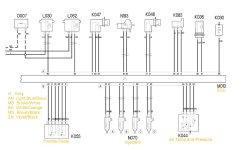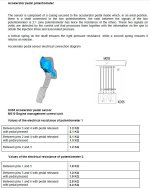my ducato starts and ticks over fine, revs up to 1500 then power falls back to tickover . If you hold throttle down, engine will cycle every few seconds, up to 1500 then fall back to tickover, then rev up to 1500 again etc. no fault codes. Diag software shows accelerator pedal responding well on a graph, so went ahead and replaced throttle body…no change. Have measured resistance of all 5 wires to throttle body, all good connections. Any ideas Would be greatly appreciated. Thanks
You are using an out of date browser. It may not display this or other websites correctly.
You should upgrade or use an alternative browser.
You should upgrade or use an alternative browser.
Technical No throttle, and no fault codes on 2.3 130 ducato 2017
- Thread starter Gidz
- Start date
Currently reading:
Technical No throttle, and no fault codes on 2.3 130 ducato 2017
theoneandonly
Established member
What engine/ age, a tad more detail required. the throttle body was changed over the years with issues sometimes being water in the electricals and a new body sometimes needed /came with a new mini loom.
woops just seen the title again a 2017. The throttle body is not as tempremental as earlier models. The only one i know that failed had already had serious carbon problems and a clogged lpegr cooler twice.
the throttle pedal position has 2 sensors have you compared the 2. Data was collected with multiecuscan. a low mileage 2017 engine

woops just seen the title again a 2017. The throttle body is not as tempremental as earlier models. The only one i know that failed had already had serious carbon problems and a clogged lpegr cooler twice.
the throttle pedal position has 2 sensors have you compared the 2. Data was collected with multiecuscan. a low mileage 2017 engine
Thanks for detailed graph, I am now thinking that the TB is a bum steer, old one stripped down appears to be fine. Engine is 2.3 130 bhp Multijet registered 2019 done 28k miles.
i am now perusing a glow plug fault light, which I thought would have nothing to do with this, but I am wondering if engine has been limited to 1500 rpm by limp mode……seems a drastic limit on rpm? but have seen it mentioned on other chats
thanks. will know more tomorrow.
i am now perusing a glow plug fault light, which I thought would have nothing to do with this, but I am wondering if engine has been limited to 1500 rpm by limp mode……seems a drastic limit on rpm? but have seen it mentioned on other chats
thanks. will know more tomorrow.
Ok, problem with glow plugs fixed…loose connection! glow plug fault cleared.
I now still have tickover plus accelerator limited to about 1500 rpm ..no error codes but do see the orange warning triangle on dash. Without any codes I am clueless as to what the fault may be.
anyone got any ideas….anyone else seen this very repeatable 1500rpm limit on a ducato?
I now still have tickover plus accelerator limited to about 1500 rpm ..no error codes but do see the orange warning triangle on dash. Without any codes I am clueless as to what the fault may be.
anyone got any ideas….anyone else seen this very repeatable 1500rpm limit on a ducato?
Thanks for the pointers…my son is doing the checking and has used some software on a laptop and also a handheld bluetooth reader…not sure what software they are running..I will ask him.What system are you using to read codes?
is fuel rail pressure steady or dropping when ?
Brake light switch stuck on?
Clutch switch?
re fuel rail pressure, i will ask him to look at it cheers
brake lights….work fine on and off with pedal
clutch switch, not come across this, presumably this is only readable from a diag device?
we have got good fuel pressure but not sure when it falls off..need to test this, brake and clutch switches both good, thanks for advice so far soUpdate..he used mulitecuscan , eobdfacile pro and launch proThanks for the pointers…my son is doing the checking and has used some software on a laptop and also a handheld bluetooth reader…not sure what software they are running..I will ask him.
re fuel rail pressure, i will ask him to look at it cheers
brake lights….work fine on and off with pedal
clutch switch, not come across this, presumably this is only readable from a diag device?
ThankyouThe handbook shows several systems could cause the Amber warning lamp to come on
- Joined
- Nov 3, 2014
- Messages
- 824
- Points
- 283
Hi
If the vehicle is giving a warning lamp there would normally be an associated fault code.
Unlike a petrol, the throttle body on a diesel has nothing to do with regulating engine power and has no direct link to the accelerator pedal, it's used as part of the EGR process.
If you are getting only 1500 RPM with the vehicle stationary then the injectors are only supplying a tiny amount of fuel compared to on-the-road running. I can only think that this is being deliberately controlled by the ECU because it "thinks" that the accelerator pedal is only just above the idling position. With the accelerator pedal at the idling end, the idling speed (typically 800 RPM) is then controlled by the ECU so that it is immune to load variations like taking a big current from the alternator or moving the steering.
The accelerator ("throttle") pedal unit has two potentiometers, i.e. dual redundancy, so that a fault in one cannot make the vehicle either stop or take off at max power. Each pot is supplied by +5 volts at one end (From the ECU) and is grounded at the other end. The sliders each feed a variable voltage to the ECU, with one being arranged to be always about twice the other. If the ECU sees an incorrect relationship between the two signals it should throw a fault code but the vehicle can still be driven. I guess it's possible that once you stop it then doesn't allow the vehicle to be driven again ?
You have checked out the wires to the pedal, are you able to do a resistance check of the pedal unit itself ? You should see smooth variation. Alternatively, probe the pot voltages to ground and see what they are doing as you move the pedal. See extracts from eLearn and the training manual.
If the vehicle is giving a warning lamp there would normally be an associated fault code.
Unlike a petrol, the throttle body on a diesel has nothing to do with regulating engine power and has no direct link to the accelerator pedal, it's used as part of the EGR process.
If you are getting only 1500 RPM with the vehicle stationary then the injectors are only supplying a tiny amount of fuel compared to on-the-road running. I can only think that this is being deliberately controlled by the ECU because it "thinks" that the accelerator pedal is only just above the idling position. With the accelerator pedal at the idling end, the idling speed (typically 800 RPM) is then controlled by the ECU so that it is immune to load variations like taking a big current from the alternator or moving the steering.
The accelerator ("throttle") pedal unit has two potentiometers, i.e. dual redundancy, so that a fault in one cannot make the vehicle either stop or take off at max power. Each pot is supplied by +5 volts at one end (From the ECU) and is grounded at the other end. The sliders each feed a variable voltage to the ECU, with one being arranged to be always about twice the other. If the ECU sees an incorrect relationship between the two signals it should throw a fault code but the vehicle can still be driven. I guess it's possible that once you stop it then doesn't allow the vehicle to be driven again ?
You have checked out the wires to the pedal, are you able to do a resistance check of the pedal unit itself ? You should see smooth variation. Alternatively, probe the pot voltages to ground and see what they are doing as you move the pedal. See extracts from eLearn and the training manual.
Attachments
Thanks I will look into this next. Just to clarify, it will ’rev up‘ from 800rpm to about 1500rpm when the accelerator is pressed but then falls back to 800. If you floor the accelerator it cycles through from 800 to 1500 then drops back to 800 and ramps up again to 1500 and so on, so I agree that I think that the ecu is controlling this, but it certainly ’sees’ the accelerator reliably up to 1500rpm and its very consistent.Hi
If the vehicle is giving a warning lamp there would normally be an associated fault code.
Unlike a petrol, the throttle body on a diesel has nothing to do with regulating engine power and has no direct link to the accelerator pedal, it's used as part of the EGR process.
If you are getting only 1500 RPM with the vehicle stationary then the injectors are only supplying a tiny amount of fuel compared to on-the-road running. I can only think that this is being deliberately controlled by the ECU because it "thinks" that the accelerator pedal is only just above the idling position. With the accelerator pedal at the idling end, the idling speed (typically 800 RPM) is then controlled by the ECU so that it is immune to load variations like taking a big current from the alternator or moving the steering.
The accelerator ("throttle") pedal unit has two potentiometers, i.e. dual redundancy, so that a fault in one cannot make the vehicle either stop or take off at max power. Each pot is supplied by +5 volts at one end (From the ECU) and is grounded at the other end. The sliders each feed a variable voltage to the ECU, with one being arranged to be always about twice the other. If the ECU sees an incorrect relationship between the two signals it should throw a fault code but the vehicle can still be driven. I guess it's possible that once you stop it then doesn't allow the vehicle to be driven again ?
You have checked out the wires to the pedal, are you able to do a resistance check of the pedal unit itself ? You should see smooth variation. Alternatively, probe the pot voltages to ground and see what they are doing as you move the pedal. See extracts from eLearn and the training manual.
I have noticed in the manual that there is a ‘ third deteriation threshold’ for poor oil quality which limits the engine to 1500 rpm…and the coincidence in the 1500 rpm that I am seeing seems too much to be a coincidence. BTW we have new oil and filter and signalled a service done to ecu. still seems odd that we have no fault code with amber light. thanks again
Thanks gain for the diagrams…very usefulThanks I will look into this next. Just to clarify, it will ’rev up‘ from 800rpm to about 1500rpm when the accelerator is pressed but then falls back to 800. If you floor the accelerator it cycles through from 800 to 1500 then drops back to 800 and ramps up again to 1500 and so on, so I agree that I think that the ecu is controlling this, but it certainly ’sees’ the accelerator reliably up to 1500rpm and its very consistent.
I have noticed in the manual that there is a ‘ third deteriation threshold’ for poor oil quality which limits the engine to 1500 rpm…and the coincidence in the 1500 rpm that I am seeing seems too much to be a coincidence. BTW we have new oil and filter and signalled a service done to ecu. still seems odd that we have no fault code with amber light. thanks again
Re question about stopping and driving, van is on my drive and given lack of power I cant risk taking it on the road so it’s not moving at the momentHi
If the vehicle is giving a warning lamp there would normally be an associated fault code.
Unlike a petrol, the throttle body on a diesel has nothing to do with regulating engine power and has no direct link to the accelerator pedal, it's used as part of the EGR process.
If you are getting only 1500 RPM with the vehicle stationary then the injectors are only supplying a tiny amount of fuel compared to on-the-road running. I can only think that this is being deliberately controlled by the ECU because it "thinks" that the accelerator pedal is only just above the idling position. With the accelerator pedal at the idling end, the idling speed (typically 800 RPM) is then controlled by the ECU so that it is immune to load variations like taking a big current from the alternator or moving the steering.
The accelerator ("throttle") pedal unit has two potentiometers, i.e. dual redundancy, so that a fault in one cannot make the vehicle either stop or take off at max power. Each pot is supplied by +5 volts at one end (From the ECU) and is grounded at the other end. The sliders each feed a variable voltage to the ECU, with one being arranged to be always about twice the other. If the ECU sees an incorrect relationship between the two signals it should throw a fault code but the vehicle can still be driven. I guess it's possible that once you stop it then doesn't allow the vehicle to be driven again ?
You have checked out the wires to the pedal, are you able to do a resistance check of the pedal unit itself ? You should see smooth variation. Alternatively, probe the pot voltages to ground and see what they are doing as you move the pedal. See extracts from eLearn and the training manual.
I'm using EOBD Facile PRO, Launch Pro and have scanned with multiecuscan, I can access all ecus in the vehicle.What system are you using to read codes?
is fuel rail pressure steady or dropping when ?
Brake light switch stuck on?
Clutch switch?
Both throttle pots are reading and returning voltage which tracks with pedal position, fuel rail pressure tracks with requested pressure and doesn't drop off, obviously the desired pressure is up and down like a yoyo when the van is hunting between 800-1500rpm.
The only odd thing I've noticed in the sensor info is the EGR valves are commanded to >100%, high pressure is reading 148% and low pressure reading 128%
The ecu has had the oil degradation has been reset, service has been reset, last thing today I tried to run a static regen of the dpf once it was upto temperature but the throttle was acting the same under full ECU control
Last edited:
Hi all, we finally got to the bottom of this so thought that I would complete the thread with the solution should anyone else see this problem in future.
As you might gather we had been doing quite a lot of work on the engine following a catastrophic valve failure ( 4 years old and this nice guys at Fiat told us where to get off as we had not had it serviced with them )
)
Not sure if was a result of the engine going bang a while ago, or because we had had the battery disconnected and reconnected many times ( and may have inadvertently missed the 10 seconds between off and disconnect advised in manual), but we found that the VIN number was missing from engine ECU data.
We sent the ECU off to a guy in Stoke-on-Trent called Dashmaster, who managed to reinstate the VIN ..problem solved.
We suspect that the ECU put itself in a safe mode when it could not see VIN..or saw a VIN mismatch.
Anyway..happy days and thanks for all of the advice .
As you might gather we had been doing quite a lot of work on the engine following a catastrophic valve failure ( 4 years old and this nice guys at Fiat told us where to get off as we had not had it serviced with them
Not sure if was a result of the engine going bang a while ago, or because we had had the battery disconnected and reconnected many times ( and may have inadvertently missed the 10 seconds between off and disconnect advised in manual), but we found that the VIN number was missing from engine ECU data.
We sent the ECU off to a guy in Stoke-on-Trent called Dashmaster, who managed to reinstate the VIN ..problem solved.
We suspect that the ECU put itself in a safe mode when it could not see VIN..or saw a VIN mismatch.
Anyway..happy days and thanks for all of the advice .







